往复式内燃机和燃料的前景
燃料技术的发展趋势
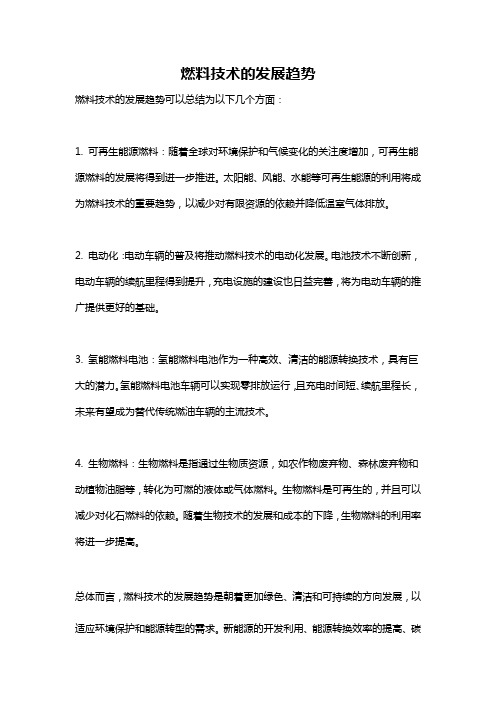
燃料技术的发展趋势
燃料技术的发展趋势可以总结为以下几个方面:
1. 可再生能源燃料:随着全球对环境保护和气候变化的关注度增加,可再生能源燃料的发展将得到进一步推进。
太阳能、风能、水能等可再生能源的利用将成为燃料技术的重要趋势,以减少对有限资源的依赖并降低温室气体排放。
2. 电动化:电动车辆的普及将推动燃料技术的电动化发展。
电池技术不断创新,电动车辆的续航里程得到提升,充电设施的建设也日益完善,将为电动车辆的推广提供更好的基础。
3. 氢能燃料电池:氢能燃料电池作为一种高效、清洁的能源转换技术,具有巨大的潜力。
氢能燃料电池车辆可以实现零排放运行,且充电时间短、续航里程长,未来有望成为替代传统燃油车辆的主流技术。
4. 生物燃料:生物燃料是指通过生物质资源,如农作物废弃物、森林废弃物和动植物油脂等,转化为可燃的液体或气体燃料。
生物燃料是可再生的,并且可以减少对化石燃料的依赖。
随着生物技术的发展和成本的下降,生物燃料的利用率将进一步提高。
总体而言,燃料技术的发展趋势是朝着更加绿色、清洁和可持续的方向发展,以适应环境保护和能源转型的需求。
新能源的开发利用、能源转换效率的提高、碳
排放的降低等是燃料技术发展的重要方向。
2024年无油往复式活塞压缩机市场发展现状

2024年无油往复式活塞压缩机市场发展现状概述无油往复式活塞压缩机是一种广泛应用于工业领域的压缩机,其特点是无需润滑油,因此可以避免油污染和维护成本。
本文将对无油往复式活塞压缩机市场的发展现状进行分析,并探讨其未来的发展趋势。
市场规模及前景目前,全球无油往复式活塞压缩机市场规模庞大,市场需求稳定增长。
据统计,2019年全球无油往复式活塞压缩机市场规模达到XX亿美元,并预计到2025年将达到XX亿美元。
市场前景广阔,尤其在一些对环境友好要求较高的行业,如食品加工、制药、电子等领域,无油往复式活塞压缩机的需求将持续增长。
技术发展趋势1. 高效能随着节能环保意识的提高,无油往复式活塞压缩机在能源利用效率方面的要求越来越高。
未来的发展趋势是提高压缩机的能效,降低能源消耗,并减少对环境的污染。
2. 智能化无油往复式活塞压缩机市场正逐渐迎来智能化的时代。
通过引入智能控制系统,压缩机的运行状态可以进行实时监测和分析,从而实现运行的自动化和优化控制。
智能化技术的应用将提高压缩机的可靠性和稳定性,并带来更高的生产效率。
3. 节能减排环境保护已成为全球关注的焦点,无油往复式活塞压缩机作为一种无油润滑的压缩机,具有更低的碳排放和更小的环境污染。
未来的发展趋势是进一步降低压缩机的能源消耗和碳排放,以满足低碳经济的需求。
市场竞争格局目前,全球无油往复式活塞压缩机市场竞争较为激烈,主要的厂商包括XX公司、XX公司和XX公司等。
这些厂商通过提供高品质、高性能和高可靠性的产品来争夺市场份额。
根据市场研究,XX公司是全球最大的无油往复式活塞压缩机制造商,并占据了相当大的市场份额。
发展机遇与挑战机遇•全球经济增长带来的市场需求增加,为无油往复式活塞压缩机市场提供了机遇。
•环境保护政策的推动,促使企业更加倾向于采购无油往复式活塞压缩机。
•技术的不断进步和创新,为压缩机行业的发展提供了新的机遇。
挑战•市场竞争激烈,企业需要不断提升产品质量和技术水平来赢得竞争优势。
内燃机技术的发展及应用前景分析
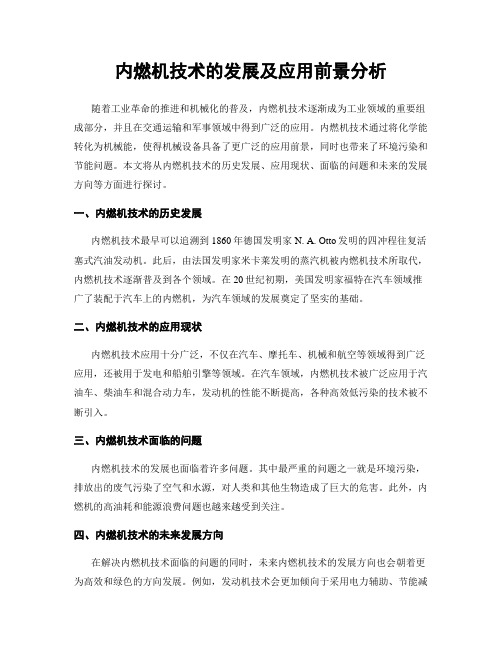
内燃机技术的发展及应用前景分析随着工业革命的推进和机械化的普及,内燃机技术逐渐成为工业领域的重要组成部分,并且在交通运输和军事领域中得到广泛的应用。
内燃机技术通过将化学能转化为机械能,使得机械设备具备了更广泛的应用前景,同时也带来了环境污染和节能问题。
本文将从内燃机技术的历史发展、应用现状、面临的问题和未来的发展方向等方面进行探讨。
一、内燃机技术的历史发展内燃机技术最早可以追溯到1860年德国发明家N. A. Otto发明的四冲程往复活塞式汽油发动机。
此后,由法国发明家米卡莱发明的蒸汽机被内燃机技术所取代,内燃机技术逐渐普及到各个领域。
在20世纪初期,美国发明家福特在汽车领域推广了装配于汽车上的内燃机,为汽车领域的发展奠定了坚实的基础。
二、内燃机技术的应用现状内燃机技术应用十分广泛,不仅在汽车、摩托车、机械和航空等领域得到广泛应用,还被用于发电和船舶引擎等领域。
在汽车领域,内燃机技术被广泛应用于汽油车、柴油车和混合动力车,发动机的性能不断提高,各种高效低污染的技术被不断引入。
三、内燃机技术面临的问题内燃机技术的发展也面临着许多问题。
其中最严重的问题之一就是环境污染,排放出的废气污染了空气和水源,对人类和其他生物造成了巨大的危害。
此外,内燃机的高油耗和能源浪费问题也越来越受到关注。
四、内燃机技术的未来发展方向在解决内燃机技术面临的问题的同时,未来内燃机技术的发展方向也会朝着更为高效和绿色的方向发展。
例如,发动机技术会更加倾向于采用电力辅助、节能减排,提高燃油利用率;发动机的材料、制造工艺等也会更加环保和符合可持续发展的发展趋势。
同时有关部门还会通过出台各种政策、法规来引导和推动内燃机技术的发展,这些政策旨在通过调整机车、汽车以及制造业的内燃机技术和机械设备的使用,来使生产、交通系统高效低能耗,并达到减少能源消耗和环境污染的目的。
五、结论内燃机技术在工业领域中的应用具有广泛的重要性,然而,它也面临着重大的问题。
内燃机的未来发展趋势
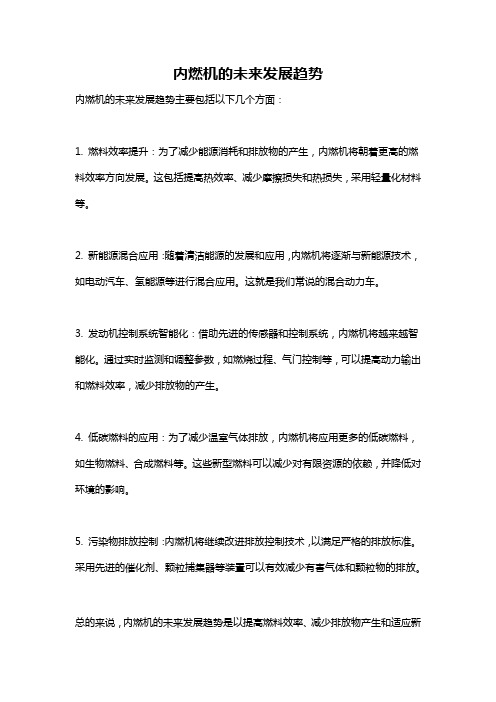
内燃机的未来发展趋势
内燃机的未来发展趋势主要包括以下几个方面:
1. 燃料效率提升:为了减少能源消耗和排放物的产生,内燃机将朝着更高的燃料效率方向发展。
这包括提高热效率、减少摩擦损失和热损失,采用轻量化材料等。
2. 新能源混合应用:随着清洁能源的发展和应用,内燃机将逐渐与新能源技术,如电动汽车、氢能源等进行混合应用。
这就是我们常说的混合动力车。
3. 发动机控制系统智能化:借助先进的传感器和控制系统,内燃机将越来越智能化。
通过实时监测和调整参数,如燃烧过程、气门控制等,可以提高动力输出和燃料效率,减少排放物的产生。
4. 低碳燃料的应用:为了减少温室气体排放,内燃机将应用更多的低碳燃料,如生物燃料、合成燃料等。
这些新型燃料可以减少对有限资源的依赖,并降低对环境的影响。
5. 污染物排放控制:内燃机将继续改进排放控制技术,以满足严格的排放标准。
采用先进的催化剂、颗粒捕集器等装置可以有效减少有害气体和颗粒物的排放。
总的来说,内燃机的未来发展趋势是以提高燃料效率、减少排放物产生和适应新
技术的发展方向,以满足更严格的环境要求。
往复式内燃机

2、四行程汽油引擎的運轉
凸輪
C
吸氣
壓縮
爆炸
排氣
3、二行程汽油引擎的運轉
掃 氣 口
4.二行程與四行程汽油引擎的優缺點比較
二行程汽油引擎的優點
1、小型輕便,能夠產生高出力。 2、無氣門機構、構造簡單、價格低。 3、動力次數多,運轉較平穩。 4、出力較同汽缸大小之四行程引擎大。
二行程汽油引擎的缺點 1、進排氣不完全,容積效率較低。 2、燃料浪費較多,使用成本較高。 3、潤滑困難,容易造成空氣汚染。 4、曲軸箱須做成氣密狀態。
第二章
往復式內燃機的作用原理
2-1行程與循環
一、往復式內燃機的運轉狀態是反覆進行下列四種作 用:
1. 2. 3. 4.
吸入(氣) 作用 壓縮作用 爆炸(動力)作用 排氣作用
二、吸氣、壓縮、爆炸、排氣的連續反覆動作稱為循 環。完成一循環時曲軸旋轉二圈(活塞運動四行程) 稱為四行程引擎;完成一循環時曲軸旋轉一圈(活 塞運動二行程)稱為二行程引擎。
柴油引擎的缺點
1、每馬力的重量稍大,較為笨重。 2、使用時震動大、噪音大。 3、起動較困難、加速性能遲鈍。 4、燃料系統構造精密,加工困難。 5、引擎製造成本高。
汽油引擎作用原理
(科學尋根23集 9’52”~14’30”)
第二章 習題
1.
何謂循環? 2. 繪一簡圖說明四行程汽油引擎的作用原理。 3. 繪一簡圖說明二行程汽油引擎的作用原理。 4. 與四行程比較,二行程汽油引擎有那些優缺點? 5. 與汽油引擎比較,柴油引擎有那些優缺點? 6. 柴油引擎為何被稱為壓縮點火引擎? 7. 試舉三點以上說明汽油引擎和柴油引擎的主要差異。
2-3 柴油引擎壓縮空氣之溫度與燃料自然著火溫度
内燃机技术发展趋势与挑战分析

内燃机技术发展趋势与挑战分析内燃机技术是现代工业化社会中最重要的能源转换技术之一。
随着汽车、船舶、发电机组等内燃机设备在全球范围内得到广泛应用,内燃机技术也不断进行着创新和发展。
然而,内燃机技术在面临着新的挑战的同时,也正面临着前所未有的发展机遇。
本文将分析内燃机技术的发展趋势和挑战。
一、内燃机技术的发展趋势随着全球能源环境的不断变化和发展迅速的自动化、信息化和电动化技术的推广,内燃机技术产业在面临深刻变革的同时正面临着巨大机遇。
内燃机技术的发展趋势主要表现在以下几个方面:1. 高效节能高效节能是内燃机技术的重要发展方向。
目前,国际内燃机技术发展的主要趋势是朝向高效、节能、环保、低排放的方向发展。
开发和采用新型燃烧技术、优化设计、提高热效率和改善排放是主要手段。
同时,内燃机技术还将积极运用制造技术和材料的新进展,提高零部件制造精度和使用寿命,推广新型材料和新加工技术。
2. 电动化电动化是当前全球汽车行业的发展主流。
内燃机技术正面临着电动化的冲击。
在全球范围内,越来越多的国家和地区正在推广电动汽车和混合动力汽车。
随着电动技术的不断发展和完善,电动汽车的性能也将越来越接近和超越内燃机汽车。
因此,内燃机技术需要积极应对电动化的冲击,加快技术升级和转型升级步伐,开发和推广高效、通用、模块化的内燃机技术,促进内燃机技术与电动化技术的有机融合。
3. 全球化内燃机技术的另一个发展趋势是全球化。
目前,内燃机技术已经成为全球范围内最为重要的能源转换技术之一,各国和地区之间的内燃机技术产业交流和合作越来越频繁和深入。
随着国际经济一体化进程的不断加速,产业布局和经济利益的全球化将加快内燃机技术的全球化。
二、内燃机技术的挑战虽然内燃机技术在发展趋势方面呈现出较为明显的优势,但内燃机技术也面临着前所未有的挑战。
主要表现在以下几个方面:1. 巨大的环境压力近年来,环境问题日益成为全球人们关注的焦点。
排放控制和环境保护已经成为各国政府和社会的共同责任。
简述往复式发动机的工作原理
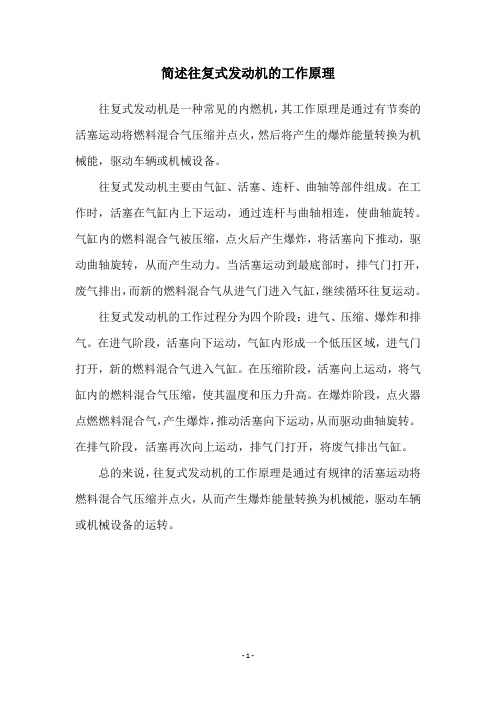
简述往复式发动机的工作原理
往复式发动机是一种常见的内燃机,其工作原理是通过有节奏的活塞运动将燃料混合气压缩并点火,然后将产生的爆炸能量转换为机械能,驱动车辆或机械设备。
往复式发动机主要由气缸、活塞、连杆、曲轴等部件组成。
在工作时,活塞在气缸内上下运动,通过连杆与曲轴相连,使曲轴旋转。
气缸内的燃料混合气被压缩,点火后产生爆炸,将活塞向下推动,驱动曲轴旋转,从而产生动力。
当活塞运动到最底部时,排气门打开,废气排出,而新的燃料混合气从进气门进入气缸,继续循环往复运动。
往复式发动机的工作过程分为四个阶段:进气、压缩、爆炸和排气。
在进气阶段,活塞向下运动,气缸内形成一个低压区域,进气门打开,新的燃料混合气进入气缸。
在压缩阶段,活塞向上运动,将气缸内的燃料混合气压缩,使其温度和压力升高。
在爆炸阶段,点火器点燃燃料混合气,产生爆炸,推动活塞向下运动,从而驱动曲轴旋转。
在排气阶段,活塞再次向上运动,排气门打开,将废气排出气缸。
总的来说,往复式发动机的工作原理是通过有规律的活塞运动将燃料混合气压缩并点火,从而产生爆炸能量转换为机械能,驱动车辆或机械设备的运转。
- 1 -。
我国内燃机发展前景展望

Internal Combustion Engine &Parts0引言目前,各国对于本国的能源或相关技术政策差异较大,而政策的出台也决定着未来动力机械的发展方向,动力机械的发展又与国家的经济发展密不可分,制约着动力机械发展的因素较多,除国家出台的政策外,包括资源条件、技术发展水平、制造业发展水平、机械设计发展水平、工程机械管理、材料工程的发展等都是影响该国动力机械发展的因素之一。
在动力机械设备中,最为常见和广泛使用的就是内燃机,其覆盖功率范围广,从1kW 到3万多kW 不等。
目前,我国内燃机的保有量数以亿计,约40%为汽油机,约60%为柴油机。
当前,世界范围内的石油资源也被人类大量的开采,但总数有限,按照目前的开采方式和使用速度,石油资源也仅能供人类使用约半个世纪,采用新型能源或替代性材料开展发动机使用的应用型研究较多,但大范围的推广还存在困难和障碍,因此,在目前以柴油机为主要农业生产用动力机械设施的条件下,节能减排成为关键。
1内燃机及其发展历程内燃机的做功原理是采用内能做功的一种动力机械装置,它采用燃料在机械内部燃烧后释放能量,这种能量被称为热能,将释放的热能进行转化,形成可以为外部机械提供动力的能量。
随着科技的不断进步和发展,内燃机应用十分广泛。
然而,内燃机采用的燃料在燃烧后会排出对大气气体产生危害的有害气体,成为当前大气污染的因素之一。
19世纪初,内燃机的雏形初现。
直至1860年,第一台内燃机被法国的莱诺伊尔制成,且为燃煤型内燃机,成为内燃机的鼻祖。
1876年,在德国的奥托的艰苦钻研下,第一台煤气型燃气内燃机被发明,且采用四冲程往复活塞式运动原理,成为燃气型内燃机的先驱,是瓦特之后在动力机方面取得成就最高的人。
1883年,第一台四冲程往复式汽油机在戴姆勒与迈巴赫的艰苦钻研和反复试验下研制成功。
1897年,第一台压缩点火的内燃机在德国被狄塞尔制成成功,被命名为“狄塞尔”柴油内燃机。
内燃机的燃料经济性分析
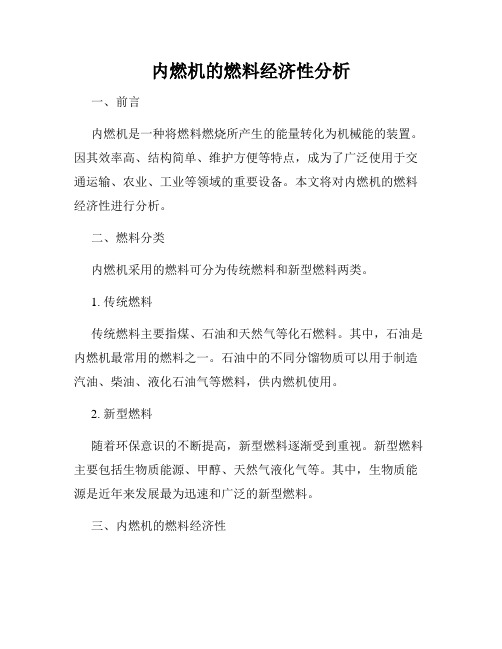
内燃机的燃料经济性分析一、前言内燃机是一种将燃料燃烧所产生的能量转化为机械能的装置。
因其效率高、结构简单、维护方便等特点,成为了广泛使用于交通运输、农业、工业等领域的重要设备。
本文将对内燃机的燃料经济性进行分析。
二、燃料分类内燃机采用的燃料可分为传统燃料和新型燃料两类。
1. 传统燃料传统燃料主要指煤、石油和天然气等化石燃料。
其中,石油是内燃机最常用的燃料之一。
石油中的不同分馏物质可以用于制造汽油、柴油、液化石油气等燃料,供内燃机使用。
2. 新型燃料随着环保意识的不断提高,新型燃料逐渐受到重视。
新型燃料主要包括生物质能源、甲醇、天然气液化气等。
其中,生物质能源是近年来发展最为迅速和广泛的新型燃料。
三、内燃机的燃料经济性燃料经济性是指燃料在引擎内燃烧中所转换为有效功的比例。
因此,燃料经济性是评价内燃机性能优劣的重要指标之一,也对于节能减排具有重要意义。
1. 传统燃料的燃料经济性传统燃料的燃料经济性取决于燃料的种类和车辆的工作状态。
通常情况下,内燃机的燃料经济性都没有达到最优化。
因为内燃机的工作过程是从冷态启动到进入正常工作状态,这个过程中会消耗大量的能量。
此外,内燃机在行驶过程中往往需要不断改变负荷,这使得燃烧过程无法保持在最佳状态,从而导致能量损失的增加。
2. 新型燃料的燃料经济性新型燃料的燃料经济性较传统燃料要高。
以生物质能源为例,其CO2排放量比燃油少,而且生物质能源可以通过清洁、可持续的能源源源不断地提供,因此生物质能源被认为是未来能源发展的一种重要选择。
四、如何提高内燃机的燃料经济性1. 优化内燃机结构内燃机的结构主要包括缸体、活塞、曲轴等部分。
通过优化内燃机结构,可以提高其燃料经济性。
比如,减少某些机械部件的摩擦损失,改变燃烧室的形状和喷油方式等。
2. 调整燃烧过程燃烧过程是影响内燃机燃料经济性的重要因素之一。
调整燃烧过程,可以使燃烧更完全、更高效。
此外,选择合适的燃油/空气混合比也可以提高内燃机的燃料经济性。
内燃机专业就业前景

内燃机专业就业前景内燃机专业属于工科类专业,培养具备内燃机的设计制造、运行与维护等方面知识和技能的人才。
内燃机广泛应用于交通工具、航空航天、能源等领域,因此内燃机专业的就业前景较为广阔。
首先,内燃机专业毕业生可以选择在汽车制造、修理、检测、销售等相关企事业单位就业。
随着汽车行业的高速发展,对于内燃机专业人才的需求量不断增加。
在汽车制造方面,毕业生可以参与内燃机的设计、改进和生产工作,也可以参与相关燃烧系统、润滑系统、冷却系统的研发和制造。
同时,在汽车修理、检测和销售方面,内燃机专业毕业生也拥有较好的就业机会。
其次,内燃机专业毕业生还可以选择在航空航天领域就业。
航空发动机作为内燃机的重要应用领域,需要大量的专业人才进行设计、制造和维护工作。
内燃机专业毕业生可以参与航空发动机的研发、试验和生产,也可以从事相关领域的技术支持和售后服务工作。
随着中国航空航天事业的蓬勃发展,内燃机专业毕业生在航空领域的就业前景较为乐观。
此外,内燃机专业毕业生还可以在能源领域找到就业机会。
内燃机作为能源转换的重要设备,广泛应用于石油、天然气、煤炭等资源的开发和利用中。
内燃机专业毕业生可以从事能源设备的设计、制造和维护工作,也可以从事能源技术与管理方面的工作。
随着能源需求的不断增长和能源结构的调整,内燃机专业毕业生在能源领域的就业前景也相对较好。
然而,随着科技的不断进步和新能源技术的快速发展,内燃机专业面临着一定的挑战。
新能源车辆的出现和发展,给传统内燃机带来了一定的冲击。
因此,内燃机专业毕业生需要不断学习和更新知识,适应技术的变革和市场的需求。
综上所述,内燃机专业就业前景较为广阔。
毕业生可以选择汽车制造、修理、检测、销售等相关领域就业,也可以选择航空航天和能源领域就业。
同时,内燃机专业也面临一定的挑战,需要毕业生不断学习和提升自己的综合素质,以适应市场的需求变化。
往复式内燃机的相关标准

往复式内燃机的相关标准
往复式内燃机是一种广泛应用于汽车、船舶、发电机组等领域的内燃机,其性能和质量对于设备的可靠性和安全性具有重要影响。
以下是往复式内燃机的相关标准:
1. GB/T 3888-2018 内燃机术语
该标准规定了内燃机的术语和定义,包括往复式内燃机、柴油机、汽油机等。
2. GB/T 5496-2018 内燃机产品型号编制方法
该标准规定了往复式内燃机产品型号的编制方法,包括型号的组成、命名规则、编码方法等。
3. GB/T 13762-2018 往复式内燃机起动马达试验方法
该标准规定了往复式内燃机起动马达的试验方法,包括试验条件、试验项目、试验方法等。
4. GB/T 18134-2018 内燃机油泵试验方法
该标准规定了内燃机油泵的试验方法,包括试验条件、试验项目、试验方法等。
5. GB/T 20711-2018 往复式内燃机气缸套的检验和验收
该标准规定了往复式内燃机气缸套的检验和验收要求,包括检验项目、检验方法、检验标准等。
6. GB/T 2428-2018 内燃机调速器
该标准规定了内燃机调速器的术语和定义、分类和结构、
性能要求等。
以上是往复式内燃机的一些相关标准,这些标准对于保证内燃机的质量和性能具有重要作用。
当前汽车内燃机发展现状以及趋势

热动导论及内燃机概况热能与动力工程主要学习动力工程及工程热物理的基础理论,学习各种能量转换及有效利用的理论和技术,受到现代动力工程师的基本训练;具有进行动力机械与热工设备设计、运行、实验研究的基本能力。
而且主要分为暖通和内燃机两个方向。
对于内燃机,以其热效率高、结构紧凑,机动性强,运行维护简便的优点著称于世。
一百多年以来,内燃机的巨大生命力经久不衰。
目前世界上内燃机的拥有量大大超过了任何其它的热力发动机,在国民经济中占有相当重要的地位。
现代内燃机更是成为了当今用量最大、用途最广、无一与之匹敌的的最重要的热能机械。
当然内燃机同样也存在着不少的缺点,主要是:对燃料的要求高,不能直接燃用劣质燃料和固体燃料;由于间歇换气以及制造的困难,单机功率的提高受到限制,现代内燃机的最大功率一般小于4万千瓦,而蒸汽机的单机功率可以高达数十万千瓦;内燃机不能反转;内燃机的噪声和废气中有害成分对环境的污染尤其突出。
可以说这一百多年来的内燃机的发展史就是人类不断革新,不断挑战克服这些缺点的历史。
内燃机发展至今,约有一个半世纪的历史了。
同其他科学一样,内燃机的每一个进步都是人类生产实践经验的概括和总结。
内燃机的发明始于对活塞式蒸汽机的研究和改进。
在它的发展史中应当特别提到的是德国人奥托和狄塞尔,正是他们在总结了前人无数实践经验的基础上,对内燃机的工作循环提出了较为完善的奥托循环和狄塞尔循环,才使得到他们为止几十年间无数人的实践和创造活动得到了一个科学地总结,并有了质的飞跃,他们将前任粗浅的、纯经验的、零乱无序的的经验,加以继承、发展、总结、提高,找出了规律性,为现代汽油机和柴油机热力循环奠定了热力学基础,为内燃机的发展做出了伟大的贡献。
我们通常所说的内燃机是指活塞式内燃机。
活塞式内燃机以往复活塞式最为普遍。
活塞式内燃机将燃料和空气混合,在其气缸内燃烧,释放出的热能使气缸内产生高温高压的燃气。
燃气膨胀推动活塞作功,再通过曲轴连杆机构或其他机构将机械功输出,驱动从动机械工作。
往复式内燃机国际标准

往复式内燃机国际标准一、内燃机往复式内燃机是一种利用燃料在汽缸内燃烧产生高温高压燃气来推动活塞往复运动,从而对外输出机械功的动力机械。
其基本组成包括燃烧系统、动力系统、冷却系统、润滑系统、供给系统等。
二、声学和声学测量往复式内燃机在运转过程中会产生噪声,对其声学性能进行测量和评估是内燃机设计和性能评价的重要方面。
国际标准中规定了内燃机声学测量的方法、噪声等级等要求。
三、消防往复式内燃机在运转过程中存在火灾风险,因此需要采取相应的消防措施以保障安全。
国际标准中规定了内燃机的消防安全要求,包括灭火器材的配备、防火措施等。
四、词汇往复式内燃机相关的术语和词汇,包括各种专业术语的定义、解释和使用方法等。
五、道路车辆内燃机道路车辆内燃机是一种常见的往复式内燃机,其设计和性能直接影响到车辆的动力和经济性能。
国际标准中规定了道路车辆内燃机的各项性能指标、排放标准等要求。
六、图形符号往复式内燃机相关的图形符号,包括各种图形符号的定义、绘制方法和使用规范等。
这些图形符号主要用于内燃机的设计、制造和使用过程中的标注和说明。
七、振动、冲击和振动测量往复式内燃机在运转过程中会产生振动和冲击,这些振动和冲击可能会对机器本身和周围环境造成不良影响。
因此,需要对内燃机的振动和冲击进行测量和评估,以确保其符合相关标准要求。
国际标准中规定了内燃机的振动测量方法、振动等级等要求。
八、能源和热传导工程综合往复式内燃机在运转过程中需要消耗大量的能源,同时也产生大量的热能。
国际标准中规定了内燃机的能效标准、热效率等要求,以促进能源的有效利用和减少环境污染。
九、空气质量往复式内燃机在运转过程中会排放出大量的废气,这些废气中的有害物质会对环境和人体健康造成不良影响。
因此,需要对内燃机的排放进行控制和管理,以确保其符合相关环保标准要求。
国际标准中规定了内燃机的排放标准、空气质量等级等要求。
十、旋转-往复式机构及其部件往复式内燃机中的旋转-往复式机构是其核心部件之一,其设计和制造质量直接影响到整个内燃机的性能和使用寿命。
中国内燃机发电机组行业市场现状及未来发展趋势分析报告

中国内燃机发电机组行业市场现状及未来发展趋势分析
报告
摘要
近年来,中国内燃机发电机组行业表现突出,从2024年到2024年,
中国内燃机发电机组整体行业市场规模有较大幅度增长,市场形势将在2024年持续向好。
本文结合市场现状和未来趋势,对中国内燃机发电机
组行业市场现状及未来发展趋势进行分析,探讨未来的发展方向。
一、中国内燃机发电机组行业市场现状
目前,中国内燃机发电机组行业总体发展态势积极向上。
根据中国机
械工业百强企业发布的报告,2024年,内燃机发电机组行业市场规模较2024年上升2.6%,达到4349.4亿元;2024年上升5.3%,达到4578.0亿元;2024年上升9.2%,达到5000.1亿元;2024年上升10.2%,达到5500.4亿元;2024年上升13.2%,达到6232.2亿元;2024年上升12.3%,达到6986.7亿元。
从2024年到2024年,内燃机发电机组行业总体市场规
模有较大幅度增长。
二、未来发展趋势
未来,中国内燃机发电机组行业将会进入一个以发展质量和效率为基
础的发展阶段。
首先,以环保为导向,拥抱新能源和清洁能源,推动发电
机组产品能效指标、环保指标的提升,满足市场新需求。
其次,以提升产
品品质为主,提升研发技术,推进新产品的技术突破和产品升级,为客户
提供更为丰富的产品选择。
燃机市场现状和发展趋势
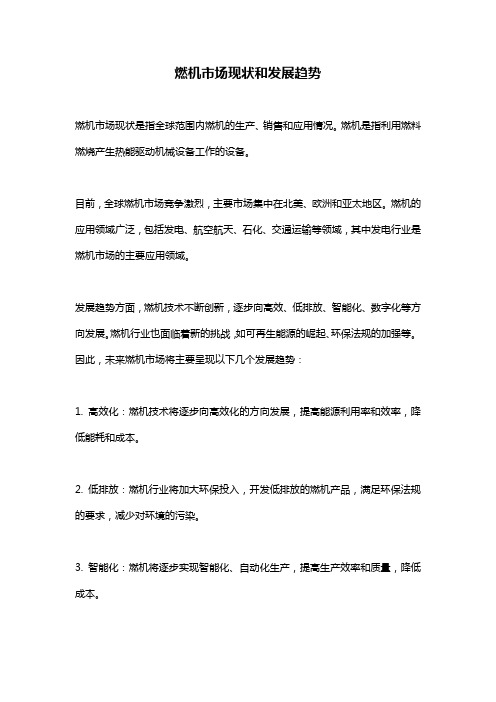
燃机市场现状和发展趋势
燃机市场现状是指全球范围内燃机的生产、销售和应用情况。
燃机是指利用燃料燃烧产生热能驱动机械设备工作的设备。
目前,全球燃机市场竞争激烈,主要市场集中在北美、欧洲和亚太地区。
燃机的应用领域广泛,包括发电、航空航天、石化、交通运输等领域,其中发电行业是燃机市场的主要应用领域。
发展趋势方面,燃机技术不断创新,逐步向高效、低排放、智能化、数字化等方向发展。
燃机行业也面临着新的挑战,如可再生能源的崛起、环保法规的加强等。
因此,未来燃机市场将主要呈现以下几个发展趋势:
1. 高效化:燃机技术将逐步向高效化的方向发展,提高能源利用率和效率,降低能耗和成本。
2. 低排放:燃机行业将加大环保投入,开发低排放的燃机产品,满足环保法规的要求,减少对环境的污染。
3. 智能化:燃机将逐步实现智能化、自动化生产,提高生产效率和质量,降低成本。
4. 数字化:燃机行业将通过数字化技术实现生产过程的数字化、信息化,提高生产管理效率和质量。
5. 可再生能源:随着可再生能源的崛起,燃机的应用领域将受到一定的冲击,但在一定时期内,燃机仍将是主要的发电设备之一。
列举往复机械的工程应用
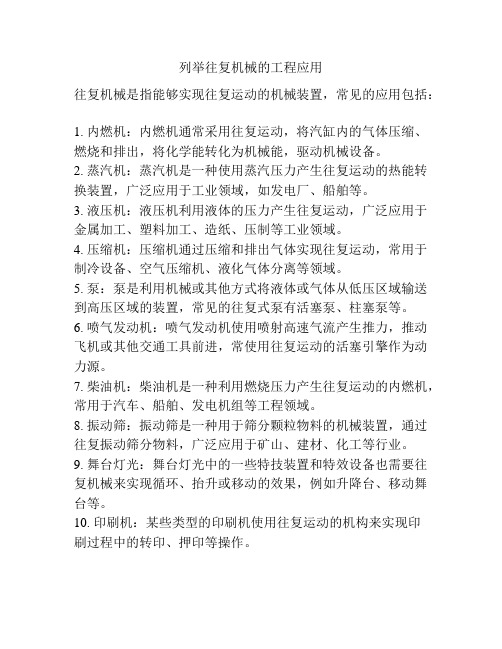
列举往复机械的工程应用
往复机械是指能够实现往复运动的机械装置,常见的应用包括:
1. 内燃机:内燃机通常采用往复运动,将汽缸内的气体压缩、燃烧和排出,将化学能转化为机械能,驱动机械设备。
2. 蒸汽机:蒸汽机是一种使用蒸汽压力产生往复运动的热能转换装置,广泛应用于工业领域,如发电厂、船舶等。
3. 液压机:液压机利用液体的压力产生往复运动,广泛应用于金属加工、塑料加工、造纸、压制等工业领域。
4. 压缩机:压缩机通过压缩和排出气体实现往复运动,常用于制冷设备、空气压缩机、液化气体分离等领域。
5. 泵:泵是利用机械或其他方式将液体或气体从低压区域输送到高压区域的装置,常见的往复式泵有活塞泵、柱塞泵等。
6. 喷气发动机:喷气发动机使用喷射高速气流产生推力,推动飞机或其他交通工具前进,常使用往复运动的活塞引擎作为动力源。
7. 柴油机:柴油机是一种利用燃烧压力产生往复运动的内燃机,常用于汽车、船舶、发电机组等工程领域。
8. 振动筛:振动筛是一种用于筛分颗粒物料的机械装置,通过往复振动筛分物料,广泛应用于矿山、建材、化工等行业。
9. 舞台灯光:舞台灯光中的一些特技装置和特效设备也需要往复机械来实现循环、抬升或移动的效果,例如升降台、移动舞台等。
10. 印刷机:某些类型的印刷机使用往复运动的机构来实现印
刷过程中的转印、押印等操作。
GBT 6072.1-2000 往复式内燃机 性能 第1部分:标准基准状况,功率、燃料消耗和机油消耗的标定及试验方法

管部门 任何进一步的附加要求须经制造厂和客户共同商定
标准基准状况
为了确定发动机的功率和燃料消耗量 应采用下列标准基准状况
总气压
空气温度
相对湿度
增压中冷介质温度
注 在温度为
相对湿度为 时 相应的水蒸气分压为
因此相应的干气压为
辅助设备
为了明确表示确定功率输出的条件 必须区分出影响发动机终端轴输出的 以及为发动机持续或重 复使用所必需的辅助设备 见附录 标准的附录
燃料消耗率 发动机每单位功率和单位时间内所消耗的燃料量
燃料消耗率 在 标准功率时的燃料消耗率
供油量 燃料喷射系统在每工作循环内供给的计量燃料容量 质量
供油率 燃料喷射系统在发动机每工作循环 每升工作容积内供给的计量燃料容量 质量
机油消耗量 发动机每单位时间内消耗的机油量
中
试验
验收试验 对制造质量进行全面检查 以确认合同承诺业已达到的试验
和
所规定的基本从属辅助设备
和
所规定的基本独立辅助设备
和
所规定的非基本从属辅助设备
和 中所列辅助设备吸收的功率可能很重要 在这种情况下 应标明其功率要求
附录 所列系典型辅助设备示例
功率使用的类型
功率使用有持续功率 超负荷功率和油量限定功率几种类型
超负荷功率允许使用的持续时间和频次取决于使用情况 但在调定发动机油量限制器时应有足够
本标准主要起草人 瞿俊鸣 魏善镇 姚康茂 蒋丽庆 杜任方 陆逸飞
前言
国际标准化组织
是由各国家标准化机构 成员团体 组成的全球性联合会 制定国际标
准的工作一般由 技术委员会进行 每个成员团体对某一科目感兴趣 均有权派代表参加为该科目
成立的技术委员会 政府和非政府性国际组织 通过与 联络也可参加此项工作 在所有电工标准化
汽车燃料发展现状及未来趋势分析

汽车燃料发展现状及未来趋势分析近年来,随着环境问题的日益突出,汽车燃料的发展趋势也受到了广泛关注。
本文将对当前汽车燃料的现状进行分析,并展望未来的发展趋势。
目前,汽车燃料主要分为传统燃油和新能源两大类。
传统燃油主要包括汽油和柴油,是目前全球最主要的汽车燃料。
传统燃油的优点是成熟、稳定且成本较低,但同时也存在环境污染和能源依赖的问题。
为了应对这些问题,各国纷纷推动新能源汽车的发展。
新能源汽车主要包括电动汽车和混合动力汽车。
电动汽车通过储存电能驱动电动机来实现运动。
随着电池技术的不断进步,电动汽车的续航里程不断增加,充电速度也不断提升,使得电动汽车不再受限于短程行驶。
混合动力汽车则结合了传统燃油发动机和电动机,通过电动机提供动力辅助传统发动机工作,以提高汽车的燃油效率和减少尾气排放。
这种技术的优势在于既能享受传统燃油汽车的便利,又能减少对环境的污染。
为了加速新能源汽车的普及,各国政府采取了一系列政策措施。
比如,中国政府实施了一系列补贴和减税政策,以降低新能源汽车的购车成本。
许多国家也在建设充电桩和加氢站的基础设施,以解决新能源汽车充电难的问题。
此外,各国还加大了对新能源汽车研发的投入,推动相关技术的创新和进步。
未来,汽车燃料的发展趋势将呈现以下几个方面:首先,电动汽车将成为主流。
随着电池技术的进步以及充电基础设施的建设完善,电动汽车续航里程和充电速度的提升将加速电动汽车的普及。
汽车制造商也将加大对电动汽车市场的投入,推出更多种类和价格适中的电动汽车,以满足消费者的需求。
其次,混合动力汽车将逐渐占据市场。
由于混合动力汽车兼具传统燃油汽车和电动汽车的优势,因此在过渡期内将成为消费者的重要选择。
随着混合动力技术的不断成熟和成本的降低,混合动力汽车将在未来继续得到广泛应用。
此外,生物燃料也将成为重要的燃料来源之一。
生物燃料以其可再生性和对环境的较小影响而备受关注。
尽管目前生物燃料的生产成本较高并且存在技术挑战,但随着科技的进步和投入的增加,生物燃料有望在未来成为一种重要的替代燃料。
- 1、下载文档前请自行甄别文档内容的完整性,平台不提供额外的编辑、内容补充、找答案等附加服务。
- 2、"仅部分预览"的文档,不可在线预览部分如存在完整性等问题,可反馈申请退款(可完整预览的文档不适用该条件!)。
- 3、如文档侵犯您的权益,请联系客服反馈,我们会尽快为您处理(人工客服工作时间:9:00-18:30)。
Topic InsightsProspects of Reciprocating Engines andFuelsMichael J.BrearDepartment of Mechanical Engineering,The University of Melbourne,Parkville3010,AustraliaReciprocating engines and their fuels are largely associated with road transport.This isn’t surprising.About70%of transport-sector greenhouse gas emissions today are from road vehicles[1],and these vehicles are overwhelmingly propelled by reciprocating engines.However,reciprocating engines are also widely used in other sectors,particularly off-road land transport,sea transport, and electrical power generation.Various forms of gasoline and diesel are the dominant transport fuels for several reasons.These include the scale of their primary resource,their affordability,and their high volumetric and gravi-metric energy densities.However,natural gas,liquefied petroleum gas,methanol,ethanol,and electricity also play a part in transport. Natural gas and diesel also play important roles in reciprocating engine-driven electrical power generation.The global scale of reciprocating engine use can be grasped to some extent by considering road transport alone.Road travel has roughly doubled in the last40years in terms of both the total dis-tance traveled per annum and the total number of vehicles[2], with roughly one billion vehicles on the world’s roads today.Road travel is thought likely to roughly double again by2050,with most of this growth occurring in low-to middle-income countries via greater use of light-duty passenger vehicles[2].Given the enor-mous volume of road transport occurring today,it is not surprising that reciprocating engines already contribute significantly to global emissions of greenhouse gases and other pollutants,and their adverse impact on urban air quality and mortality is featured regularly in the press.In most system-level studies[2],the use of more fuel-efficient vehicles and alternative fuels are the primary projected means to achieve road transport sector abatement.Modal shift and more productive vehicles are also important.Although full vehicle electrification and fuel cell vehicles are efficient vehicle options, Kalghatgi rightly points out in this volume that these technologies only constitute a very small fraction of the current globalfleet,and that both face significant challenges to their rapid adoption.Therefore,more effective use of increasingly efficient and clea-ner reciprocating engine-driven vehicles is the dominant means by which we will reduce vehicle emissions over the next one or two decades,at least.Similar arguments hold for other transport sec-tors in which reciprocating engines are used.As this volume attests,many opportunities remain to improve engine and fuel performance.These include new engine concepts and the use of more advanced engine subsystems,with fuel injection and after-treatment as two active areas of current research.Modal shift and more productive vehicle use should also be transformative.Our working,learning,and socializing are increa-singly taking place online,and innovation in mass transit continues rmation and communication technologies have also already disrupted the transport sector,directly not only via Uber and similar,but through less obvious,yet major,innovations such as freight path optimization,real-time vehicle and network moni-toring,and improved data-driven planning,to name a few.The uptake of greater vehicle autonomy is a logical part of this transition.In order to offset the higher upfront costs of the tech-nologies required to achieve substantial autonomy,it is expected that these vehicles willfirst appear in commercial applications in which reduced need for or complete removal of a paid driver is the major economic benefit for the business and its customers. Such examples include the displacement of conventional taxis and public transport with ride-sharing autonomous vehicles,and the displacement of freight vehicles with their autonomous equivalents.Like any capital-intensive asset,further economic benefits are then likely to be achieved by maximizing vehicle use,as is the case with conventional taxis,public transport,and freight today.Thus, heavy autonomous vehicle use over relatively long distances is likely to prove economically beneficial.In such cases,it is not obvi-ous that full vehicle electrification will follow,given range and recharging/refuelling time requirements.Rather,greater vehicle hybridization may result,with advanced reciprocating engines and cleaner fuels then continuing to play an important role.At the same time,we should not be too focused on using tech-nology alone to achieve our goals.For example,several studies have found substantially greater public health benefits from active travel(e.g.,walking,running,and cycling)displacing vehicle use,in comparison with the health benefits that arise from the increased use of lower emission vehicles for the same travel task[1].Such findings will hopefully lead to significant abatement of greenhouse gas emissions from transport as a co-benefit of improved public health—particularly when governments consider the reduced public health costs from active travel relative to investment in pub-lic transport,and dedicate routes for walking,running,and cycling.A broad perspective of the plethora of different options available makes it clear that we need to take a more system-levelapproach to the important,dual challenges of decarbonization and improved human health.Numerous technological and non-technological options can help to achieve both goals,and there are risks in ignoring potentially poor environmental or economic performance by technologies that are commonly assumed to be always beneficial or benign.Ideally,therefore,we should regulate the life-cycle emissions of greenhouse gases and other pollutants from vehicles and their fuels while integrating non-vehicle options into such analyses. Should such regulation be achieved,it is then expected to result in the continued use of reciprocating engines for several decades,while engines,fuels,vehicles,cities,and our attitudes continue to evolve.References[1]Sims R,Schaeffer R,Creutzig F,Cruz-Núñez X,D’Agosto M,Dimitriu D,et al.Transport.In:Edenhofer O,Pichs-Madruga R,Sokona Y,Farahani E,Kadner S, Seyboth K,et al.,editors.Climate change2014:mitigation of climate change.Contribution of working group III to thefifth assessment report of the intergovernmental panel on climate change.New York:Cambridge University Press;2014.p.599–670.[2]International Energy Agency(IEA).Energy technology perspectives2014.Report.Paris:IEA;2014May.396M.J.Brear/Engineering5(2019)395–396Engineering 2 (2016) xxx–xxxTopic Insights往复式内燃机和燃料的前景Michael J. BrearDepartment of Mechanical Engineering, The University of Melbourne, Parkville 3010, Australia毋庸置疑,往复式内燃机及其燃料与公路运输息息相关。
